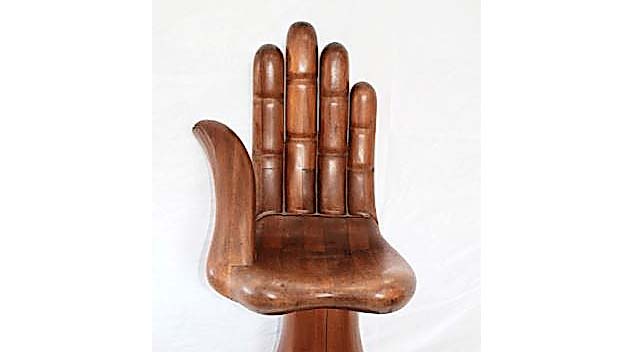#Midcentury #Southwest #Golden #Gavel #Auction #Antiques #Arts #Weekly
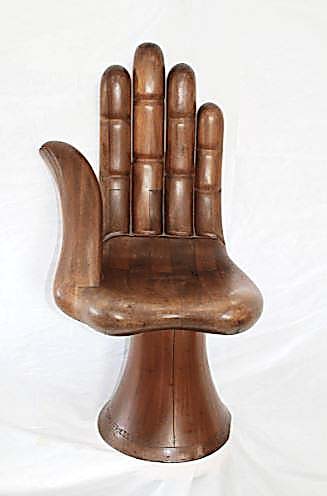
Pedro Friedeberg’s carved hand chairs have reached iconic status, having sold more than 5,000 copies since the first one was created in 1962. This chair, signed on the base, 34 inches tall, 17½ inches wide and 20 inches deep, sold for $14,760 to an online LiveAuctioneers purchaser and was the top lot in the 159-lot sale.
Review By W.A. Demers
EAST WINDSOR, CONN. — Guaranteed to make you smile, Pedro Friedeberg’s (b 1936) carved hand chairs have sold more than 5,000 copies since the first was created in 1962. One of these totems of Surrealist counterculture sold for $14,760, including buyer’s premium, at Golden Gavel’s August 8, Summer Antique Southwest Midcentury Auction. Signed on the base, the chair was 34 inches tall, 17½ inches wide and 20 inches deep. The whimsical seating is designed to allow one to sit on the palm, using the fingers as a back and arm rest. The story of its creation is recounted in an article in Architectural Digest by design editor, Hannah Martin. “When artist Pedro Friedeberg’s mentor — the painter and sculptor Mathias Goeritz — left Mexico City for a vacation in 1962, he asked the young Surrealist a favor: Give a favorite local carpenter some work,” Martin writes.
“I told him to make a hand,” Friedeberg remembers. “Then I said, ‘Why don’t you make it big enough to sit on. I thought that would be funny.” When Goeritz returned, he and Manhattan dealer Georges Keller asked to see what Friedeberg had been up to. Georges told me, “These are wonderful! I want two for New York, two for Switzerland and two more for Paris.”
Ironically, Friedeberg is said to have fallen out of love with his most famous creation. “I hate them,” he is said to have exclaimed. “They’ve become like an icon or something.”
Of course, being folk art, the chairs are widely copied, though it’s easy to identify a bona fide Friedeberg chair. “Turn one upside down,” he advises, according to Martin. “At the bottom of the base, you should see my signature burned in.”
And in this case, the all-important signature was there, ample bona fides for the LiveAuctioneers online purchaser.
The sale total was $137,222 with a sell-through rate of 92 percent. There were 268 online registered bidders and 270 in-person.
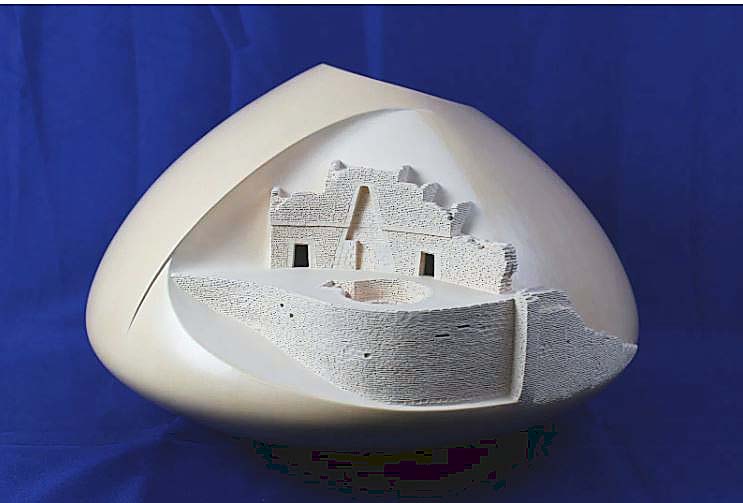
The distinctive style of Al Qöyawayma’s Hopi pottery was on display in this 1994 Southwestern jar with small architectural form, which left the gallery at $11,685. Form, textures, contrasts, shadow and the softness of desert color hues are foremost in his work, according to the artist.
A 1994 Southwestern jar with small architectural form, masterly crafted by renowned Hopi artist Al Qöyawayma, sold for $11,685. His distinctive styles of Hopi pottery that call forth images of the Southwest are twofold. One embodies figurative sculpted reliefs using the repousse’ technique, combining traditional coil construction and tactile stone polished surfaces. Another is polychrome and a future-forward version of Sikyatki pottery from the 1500s, with pieces that are carved and slipped with various clay colors. On the King Galleries website, Al Qöyawayma himself states, “My clay creations reflect the Southwest environment’s aesthetic influences and values passed down through our family. Form, textures, contrasts, shadow and the softness of desert color hues are foremost in my work.”
Fetching $4,305 was a handcrafted wide Santa Clara Pueblo vase signed Luann Tafoya. The polished clay vase with wraparound dragon carving by the renowned potter from the Pueblo of Santa Clara, N.M., exhibited the variations on classic imagery and forms for which the artist is known and measured 9 inches high by 18 inches in diameter.
There were several lots of handcrafted lighting fixtures by Michael Adams of Aurora Studios, an art metal studio that produces Arts and Crafts-era lighting and custom metalwork. These were led by a handcraft five-drop hanging fixture of hammered copper with heart cutouts and green case glass shades. Signed “Aurora Handcraft” in a great bird cage style, the fixture was bid to $5,228.
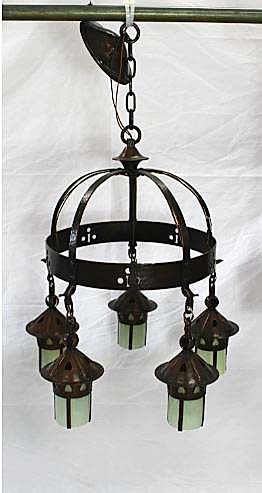
The top selling lot of several handcrafted lighting fixtures by Michael Adams of Aurora Studios, was an Arts and Crafts handcrafted five-drop hanging bird cage style fixture of hand-hammered copper with heart cutouts and green case glass shades that finished at $5,228.
Going well with the Arts and Crafts-style lighting would be a Dirk Van Erp signed hammered copper vase, circa 1913-14. With original patina, the 7-¾-inch-high-by 8-inch-wide vase brought $2,583, beating its high estimate of $1,500.
Furniture highlights included a Baker Furniture midcentury walnut credenza/server with a rattan front that surpassed its $500-$1,000 estimate to finish at $3,075. A Bernhard Pedersen & Sons rosewood Danish credenza that had great rosewood graining with tambour doors sold for $1,300.
The first lot across the block was a jewelry sparkler in the form of a 14K gold, 1.5-carat solitaire diamond ring. It was estimated $1/1,500 but did better, settling at $2,706. Marked “K&S,” the ring was size 6.
A nice retro-style watch, a 4K gold Hamilton Ventura men’s watch fetched the same price, beating its $800-$1,500 estimate. With an unconventional triangular design, the Ventura is one of the most iconic of Hamilton watches. This watch had a full monogram on the back and was cataloged as “non working,” needing a battery.
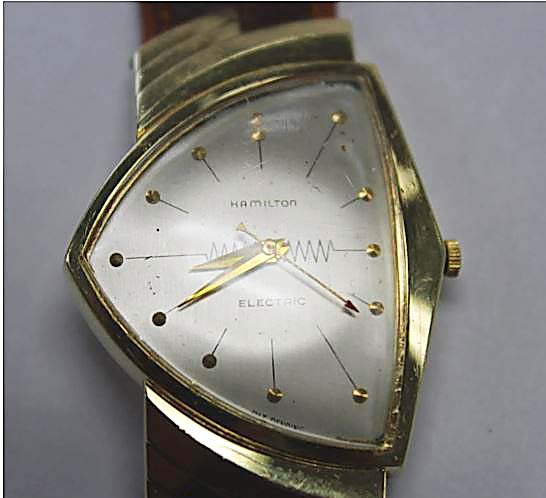
Cataloged as “non-working,” for want of a battery, this retro-style 4K gold Hamilton Ventura men’s watch still cut a great figure. With an unconventional triangular design, it beat its $800-$1,500 estimate and garnered $2,706.
Setting the table was an S. Kirk & Son sterling repoussé 83-piece flatware set weighing in at more than 80 troy ounces. It sold for $2,706.
Fine art in the sale was led by a 1939 signed John William Hilton desert landscape that was bid to $2,091, twice its high estimate. A signed Earl Biss (1947-1998) artist proof of his “Turn of The Century/Indians New Hats and Old Hats” took $750, bore a signature and title. Biss was a member of the Crow Nation. He had a classical education in the arts, having graduated from the Institute of American Indian Arts in Santa Fe, N.M. That was followed by several years of study at the San Francisco Art Institute and a year of independent study in Europe. What sets Biss’ works apart from others’ is his lively imagination and technique, which uses flowing, textured strokes of color that convey dreamlike moods.
Also in the fine art category, a Salvador Dali (1904-1989) “Zodiac Leo” lithograph, number 22 in a series of 50, found a buyer for $950. The great early lithograph was signed and numbered with an original receipt from a New York City gallery in 1974.
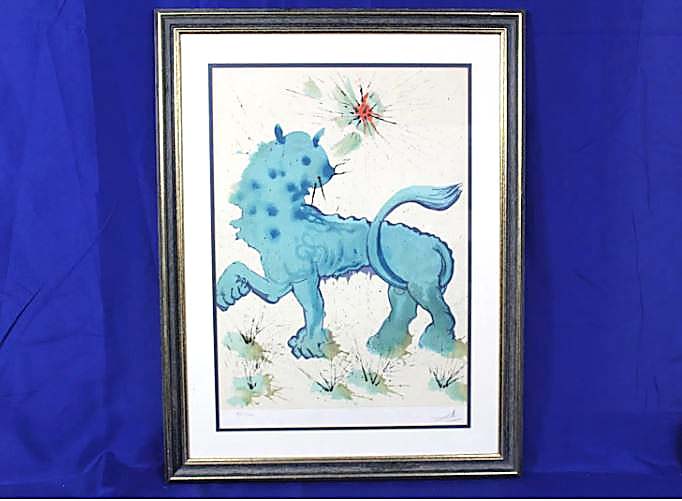
Accompanied by an original receipt from a New York City gallery, a Salvador Dali “Zodiac Leo” lithograph, 22 of 50, found a buyer for $1,169.
A high-quality Russian bronze with great detail was Albert Moritz Wolf’s (1854-1923) “Three Horses and a Sleigh” that earned $850. It measured 13 by 6 by 7 inches tall. Wolf was a German artist who worked for the Russian market in the late Nineteenth to early Twentieth Century. He is credited with having created more than 20 unique models on Russian daily life subject matter.
Standing 4¾ inches tall, a Pewabic Pottery small vase — purple, red and green in color — came with its original paper label and doubled its high estimate, finishing at $950.
Signed “Nancy Youngblood” and dated “1998,” a small swirled ribbed vase, from the Pueblo of Santa Clara, N.M., finished with black gloss, measured 3¾ by 2½ inches and sold for $700.
Prices given include the buyer’s premium as stated by the auction house. Golden Gavel hosts weekly Thursday estate auctions at 7 pm (early bird at 5:30), with specialty auctions either in person and/or on LiveAuctioneers or AuctionNinja every 1-2 months. For additional information, 860-623-2100 or www.goldengavel.com.

